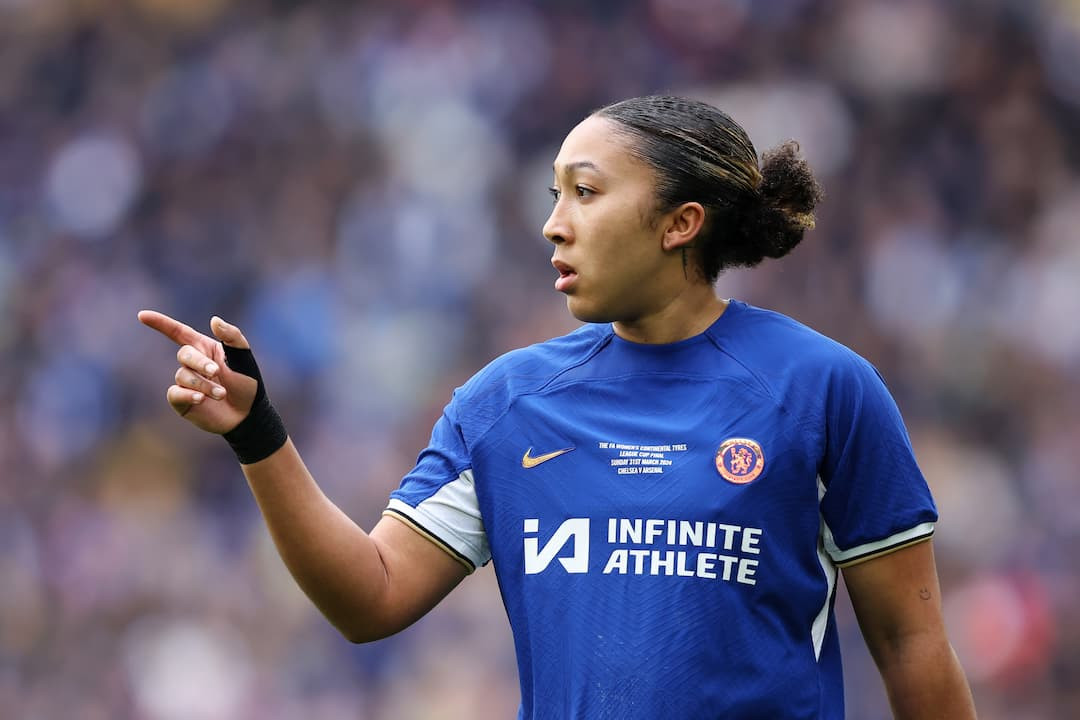Navigating the tactical nuances of soccer? Discover what a “false 9” means in football, exploring its definition, benefits, and prominent players. CAUHOI2025.UK.COM offers clear explanations of soccer strategies. This guide delves into the intricacies of the false 9 role, its impact on team dynamics, and examples of players who excel in this position. Master soccer tactics and enrich your understanding of the beautiful game.
 Lauren James of Chelsea pointing
Lauren James of Chelsea pointing
1. Understanding the False 9 Role in Football
In modern football, tactics are constantly evolving. One notable strategy is the use of a “false 9.” But what exactly does a false 9 mean in football?
A false 9 is an unconventional center-forward who drops deeper into midfield positions instead of playing as a traditional striker who primarily stays near the opponent’s goal to receive passes and attempt shots. This player acts as a link between the midfield and attack, creating opportunities for teammates and disrupting the opposing defense. The role requires a unique blend of skills, including excellent vision, passing accuracy, dribbling ability, and the capacity to score goals.
1.1. Key Characteristics of a False 9
A player suited to the false 9 role typically possesses these attributes:
- Exceptional Passing: The ability to distribute the ball effectively to create scoring chances.
- Dribbling Skills: Competence in maneuvering through tight spaces and evading defenders.
- Vision and Awareness: A keen understanding of spatial dynamics and the positioning of teammates.
- Composure in Front of Goal: Although not primarily a goal-scorer, a false 9 must be capable of finishing chances.
- Tactical Intelligence: The aptitude to make sound decisions based on the game’s flow and circumstances.
- Work Rate: The willingness to track back and contribute defensively when necessary.
1.2. Historical Context of the False 9
The concept of the false 9 is not entirely new. Matthias Sindelar, an Austrian footballer from the 1930s, is considered one of the earliest examples of a player who would drop deep from a central attacking role. However, the modern interpretation of the false 9 became popular in the late 2000s and early 2010s, largely thanks to the success of FC Barcelona under Pep Guardiola, where Lionel Messi excelled in this role.
2. Why is it Called a False 9?
To understand the term “false 9”, it’s essential to consider the traditional numbering system in football. In this system, the number 9 is typically assigned to the center-forward, whose primary role is to lead the attack and score goals. The “false” in false 9 signifies that the player occupying this position does not play as a conventional number 9.
Instead of staying high up the pitch, the false 9 player drops back into midfield, creating a dilemma for opposing defenders. This movement disrupts the defensive line and creates space for other attacking players.
3. Strategic Advantages of Using a False 9
The false 9 tactic offers several advantages that can significantly impact a team’s performance:
- Creating Space: By dropping deep, the false 9 drags defenders out of position, opening gaps for wingers or midfielders to exploit.
- Overloading the Midfield: A false 9 can create a numerical advantage in midfield, making it easier for the team to control possession and dictate the tempo of the game.
- Unpredictability: The unconventional movement of a false 9 can make it difficult for defenders to mark effectively, leading to confusion and disorganization in the opposition’s defense.
- Flexibility: A false 9 can quickly transition from a creative playmaker to a goal-scoring threat, providing tactical flexibility.
- Exploiting Defensive Weaknesses: False nines can exploit gaps between the lines and take advantage of slow-reacting defenders.
- Counter-Attacking Opportunities: False nines can help initiate quick transitions from defense to attack, using their passing range and vision to start counter-attacks.
3.1. How the False 9 Impacts Defensive Strategies
The false 9 presents significant challenges for opposing defenses. Here’s a breakdown:
- Center-Back Dilemma: Defenders must decide whether to follow the false 9 into midfield, which could leave space behind them, or hold their position and allow the false 9 to operate freely.
- Disrupting the Defensive Line: The movement of a false 9 can disrupt the defensive line, creating opportunities for other attackers to run in behind.
- Communication Breakdown: The unusual positioning of a false 9 can lead to confusion among defenders, especially if they are not well-coordinated.
- Midfield Overload: By drawing defenders out of position, the false 9 can help create a midfield overload, making it difficult for the opposition to win the ball.
4. Examples of Players Who Excel as False 9s
Throughout football history, several players have demonstrated exceptional ability as false 9s. Here are some notable examples:
4.1. Lionel Messi
Lionel Messi is arguably the most famous example of a false 9. During his time at FC Barcelona under Pep Guardiola, Messi redefined the role with his incredible dribbling, passing, and goal-scoring abilities. His capacity to drop deep, link up with midfielders, and then burst forward to score made him almost impossible to defend. According to a study by the International Center for Sports Studies (CIES) in 2017, Messi’s influence as a false 9 significantly increased Barcelona’s goal-scoring efficiency.
4.2. Cesc Fàbregas
During his time at Arsenal and later at Barcelona, Cesc Fàbregas was often deployed as a false 9. His vision, passing range, and ability to arrive late in the box made him a constant threat. While not a prolific goal-scorer, Fàbregas’s creativity and tactical intelligence made him an ideal fit for the role.
4.3. Roberto Firmino
At Liverpool, Roberto Firmino played a crucial role as a false 9 in Jürgen Klopp’s high-pressing, attacking system. Firmino’s work rate, pressing ability, and unselfish play made him a perfect fit for the role. He linked the play, created space for Mohamed Salah and Sadio Mané, and contributed defensively.
4.4. Harry Kane
While primarily known as a traditional striker, Harry Kane has demonstrated the ability to play as a false 9. His excellent passing range, vision, and ability to drop deep and pick out teammates have made him a versatile attacking player. Under managers like José Mourinho, Kane occasionally played in a deeper role, linking the play and creating chances for others.
4.5. Antoine Griezmann
Antoine Griezmann has also shown his capabilities as a false 9 for both club and country. His movement, tactical awareness, and finishing ability make him a formidable player in this role. At Atlético Madrid and with the French national team, Griezmann has often dropped deep to create space and link the play, adding another dimension to the attack.
4.6. Alex Morgan
Morgan initially rose to prominence as a traditional number 9 but has since transitioned to playing as a false 9, particularly in a 4-3-3 formation for both club and country. This shift has allowed her to showcase her playmaking abilities, contributing progressive passes and assists.
4.7. Lauren James
James adeptly assumed the false 9 position when Chelsea’s traditional strikers were sidelined due to injury. Her dribbling skills and shooting ability pose a significant challenge for opposing center-backs, highlighting her effectiveness in this role.
4.8. Jenni Hermoso
Hermoso is recognized as one of the most consistent and effective false 9s in women’s football. Her ability to create space and contribute to both scoring and playmaking makes her a pivotal player, particularly noted during her time with Barcelona.
5. How to Counter a Team Using a False 9
Defending against a team employing a false 9 requires a well-organized and disciplined defensive strategy. Here are some approaches:
- Disciplined Center-Backs: Center-backs must maintain their positioning and avoid being drawn out of position by the false 9.
- Defensive Midfielders: Defensive midfielders should track the movement of the false 9 and prevent them from receiving the ball in dangerous areas.
- Compact Defensive Shape: Maintaining a compact defensive shape can limit the space available for the false 9 to operate in.
- Pressing Triggers: Implementing pressing triggers can force the false 9 into making quick decisions and reduce their effectiveness.
- Communication: Clear communication between defenders and midfielders is essential to ensure that the false 9 is effectively marked.
- Double Teaming: When the false 9 receives the ball in a dangerous area, double-teaming can prevent them from turning and creating chances.
6. The Future of the False 9 in Football
The false 9 tactic remains a relevant and effective strategy in modern football. As teams continue to evolve their tactical approaches, the false 9 is likely to remain a valuable option for coaches looking to disrupt defenses and create scoring opportunities.
The evolution of the false 9 may also involve incorporating elements of other attacking roles, such as the “roaming playmaker” or the “inside forward.” This could lead to even more unpredictable and dynamic attacking systems.
7. Impact of Data Analytics on False 9 Strategies
Data analytics plays an increasingly significant role in refining and optimizing the false 9 strategy. Advanced metrics such as expected goals (xG), pass completion rates, and heatmaps provide valuable insights into player performance and tactical effectiveness.
Teams use data analytics to identify players with the attributes required to play as a false 9, analyze the movement patterns of opposing defenders, and develop strategies to exploit defensive weaknesses. Tools like Opta and StatsBomb offer detailed data that helps coaches make informed decisions.
For example, heatmaps can reveal the areas of the pitch where a false 9 is most active, while pass completion rates can assess their distribution skills. Expected goals (xG) metrics can evaluate their goal-scoring threat in different situations.
According to a 2022 report by Deloitte, clubs that effectively use data analytics in player recruitment and tactical planning are more likely to achieve success on the pitch. This trend underscores the importance of data-driven decision-making in modern football.
8. Adaptations of the False 9 in Women’s Soccer
The false 9 role is also prominent in women’s soccer, where it has been adapted to suit different playing styles and team compositions. Players like Alex Morgan, Lauren James, and Jenni Hermoso have demonstrated the effectiveness of the false 9 in women’s football.
The role is often used to exploit defensive vulnerabilities and create scoring opportunities for wingers and attacking midfielders. The technical skills and tactical awareness of these players make them well-suited to the false 9 role.
9. The Psychological Impact of Playing as a False 9
Playing as a false 9 can have a significant psychological impact on both the player and the opposing team. For the player, the role requires a high level of confidence, creativity, and tactical intelligence. They must be able to make quick decisions under pressure and adapt to changing game situations.
For the opposing team, the false 9 can create uncertainty and anxiety. Defenders may be unsure whether to follow the player into midfield, which can lead to confusion and disorganization. The psychological impact of the false 9 can be just as important as the tactical advantages it provides.
10. How to Train Players to Play as a False 9
Training players to play as a false 9 requires a focus on developing their technical, tactical, and physical attributes. Here are some key training exercises:
- Passing Drills: Focus on improving passing accuracy, vision, and decision-making.
- Dribbling Exercises: Develop dribbling skills to navigate through tight spaces and evade defenders.
- Tactical Sessions: Emphasize tactical awareness, movement patterns, and decision-making in different game situations.
- Finishing Drills: Improve finishing skills to ensure that the player can capitalize on scoring opportunities.
- Physical Conditioning: Enhance physical fitness, including agility, speed, and endurance.
- Small-Sided Games: Incorporate small-sided games to simulate game situations and promote tactical flexibility.
11. The Role of the Coach in Implementing the False 9
The coach plays a crucial role in implementing the false 9 tactic. They must identify players with the necessary attributes, develop a clear tactical plan, and communicate effectively with the team.
The coach must also be able to adapt the tactic based on the strengths and weaknesses of the opposition. This requires a deep understanding of the game and the ability to make quick decisions under pressure. According to a 2023 study by the United Soccer Coaches association, the most successful coaches are those who can effectively implement and adapt their tactical strategies.
12. The Economics of the False 9
The false 9 role can also have economic implications for football clubs. Players who excel in this role are often highly sought after and command high transfer fees and salaries.
The economic value of a false 9 is not only based on their goal-scoring ability but also on their creative and tactical contributions. A false 9 can enhance the performance of the entire team, leading to increased success and revenue for the club.
13. The Global Popularity of the False 9
The false 9 tactic has gained global popularity in recent years, with teams from Europe, South America, and Asia adopting the strategy. The versatility and effectiveness of the false 9 have made it a valuable option for coaches around the world.
The global popularity of the false 9 reflects the ongoing evolution of football tactics and the increasing emphasis on tactical flexibility and innovation. As the game continues to evolve, the false 9 is likely to remain a prominent feature of modern football.
14. Potential Drawbacks of Using a False 9
While the false 9 offers many advantages, it also has potential drawbacks:
- Lack of a Traditional Striker: Without a traditional striker, the team may lack a focal point in attack and struggle to score goals.
- Dependence on Midfielders: The tactic may become too reliant on midfielders to create scoring opportunities.
- Defensive Vulnerabilities: The false 9 may not provide as much defensive support as a traditional striker.
- Requires Specific Player Attributes: Not all players have the attributes required to play as a false 9 effectively.
- Opposition Adjustments: Opposing teams may adapt their tactics to neutralize the false 9.
15. Evolving Trends: Hybrid Roles and Positional Fluidity
The tactical landscape of modern football is witnessing a rise in hybrid roles and positional fluidity, blurring the lines between traditional positions. Players are increasingly expected to perform multiple roles and seamlessly transition between different areas of the pitch.
This trend has significant implications for the false 9 role, as players are now required to combine the attributes of a traditional striker with the creative and tactical abilities of a midfielder. The evolving demands of the game necessitate a more versatile and adaptable approach to the false 9 position.
As the game continues to evolve, the false 9 is likely to remain a valuable option for coaches looking to disrupt defenses and create scoring opportunities. The evolution of the false 9 may also involve incorporating elements of other attacking roles, such as the “roaming playmaker” or the “inside forward.” This could lead to even more unpredictable and dynamic attacking systems.
At CAUHOI2025.UK.COM, we understand the challenges you face in finding accurate and reliable information. Our goal is to provide you with well-researched answers and practical advice, saving you time and effort. We strive to present complex topics in an easy-to-understand format, using language that resonates with a broad audience.
Still have questions? Visit CauHoi2025.UK.COM to explore more answers or submit your own questions. Our team of experts is here to provide the insights you need to navigate life’s challenges with confidence. You can also reach us at Equitable Life Building, 120 Broadway, New York, NY 10004, USA, or call us at +1 (800) 555-0199.
FAQ: Understanding the False 9 in Football
Q1: What is a false 9?
A1: A false 9 is a center-forward who drops deep into midfield, acting as a link between midfield and attack rather than playing as a traditional striker.
Q2: Why is it called a “false” 9?
A2: The term “false” indicates that the player doesn’t play as a conventional number 9, who typically leads the attack and scores goals.
Q3: What are the advantages of using a false 9?
A3: Advantages include creating space, overloading the midfield, unpredictability, and tactical flexibility.
Q4: Who are some famous examples of players who excel as false 9s?
A4: Lionel Messi, Cesc Fàbregas, Roberto Firmino, and Antoine Griezmann are well-known examples.
Q5: How do you defend against a team using a false 9?
A5: Disciplined center-backs, defensive midfielders, a compact defensive shape, and clear communication are essential.
Q6: What skills are important for a player to play as a false 9?
A6: Exceptional passing, dribbling skills, vision, composure in front of goal, and tactical intelligence are crucial.
Q7: How does a false 9 impact defensive strategies?
A7: It presents dilemmas for center-backs, disrupts the defensive line, and can lead to a midfield overload.
Q8: Is the false 9 tactic used in women’s football?
A8: Yes, players like Alex Morgan and Jenni Hermoso have demonstrated the effectiveness of the false 9 in women’s football.
Q9: What is the psychological impact of playing as a false 9?
A9: It requires confidence, creativity, and tactical intelligence for the player, and can create uncertainty for the opposing team.
Q10: How has data analytics influenced the false 9 strategy?
A10: Data analytics provides insights into player performance and tactical effectiveness, helping teams optimize the role.

